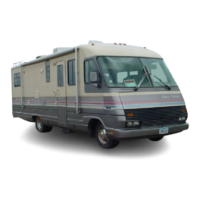40
Discovery, Discovery LXE, Pace Arrow, and Pace Arrow LXEt
Tire Vibration
Sudden tire failure is often
preceded by tire vibration.
Symptoms that can cause tire
failure are a bulge in the sidewall
or swelling in the tire carcass.
Striking an object or large hole
in the road surface can damage a
tire. Inspect the tires periodically
thereafter as rotational forces can
continue to stress damaged areas
and later manifest in tire failure.
If an unusual vibration begins or
a bulge is noticed in the sidewall,
have the tires evaluated by a
qualied professional as soon as
possible.
Tire Rotation
Tire rotation can increase the
useful life of the tires by achieving
uniform wear on all of the tires.
Have the tire manufacturer
determine the rotation pattern.
The rst tire rotation is the most
important in determining which
rotation pattern to use. Any
unusual or unique wear patterns,
or indications of uneven wear that
may have developed, should be
evaluated for possible tire rotation.
Misalignment, imbalance or other
mechanical problems may exist
and will need to be corrected prior
to rotation.
Tire Replacement
As represented within the tire
manufacturer’s published tire
data guide, the size and rated
load carrying capacity of the
original equipment tires on your
motorhome meet or exceed the
motorhome’s maximum axle
weight/load ratings. Criteria used
to determine when tire replacement
is necessary are road hazard
damage, wear, and age.
Tire replacement based on wear
is determined by either measuring
the tire’s groove depth or a visual
inspection of wear bars. Replace
tires when the groove depth is
2/32" or less on rear tires and 4/32"
or less on front tires.
Wear bars are raised areas cast
into the groove of the tire. Replace
the tire when the wear bar in
the groove is even (preferably
before) with the road surface
contact patch. A worn out tire
cannot adequately channel water
through the groove, which will
result in hydroplaning. The tire
manufacturer determines tire
replacement based on age. While
ozone inhibitors in the rubber help
extend the life expectancy of a tire,
exposure to the elements slowly
breaks down the rubber, which can
then suddenly fail when put to use.
Tires that are ve to seven years
old (depending upon environment)
are considered age worn and need
to be replaced for safety even
though the tire may not outwardly
show age weathering and still has
considerable tread.
Replacement tires on any axle,
must be of the same manufacturer
brand, model, size, and load range
and must have a load rated carrying
capacity equal to or greater than
the original equipment tires.
Mixing tires on any axle of a
different brand, model, size, load
rating and load range can cause
unusual handling and uneven
braking due to different traction
coefcient and could result in
sudden tire failure or loss of
control due to non-symmetrical
handling.
WARNING:
In many instances tire
life is not determined by
mileage or wear but by
age. Tires are subject to
weathering. Weathering
cracks can appear in the
sidewall and also run along
the edge of the tire. Though
the sidewall of the tire may
look structurally sound,
weathering can occur
inside the groove of the
tread. If any tire exhibits
age weathering, replace all
tires.
WARNING:
Any and all replacement
tires must have a rated load
carrying capacity equal to
or greater than the gross
axle weight/load ratings as
identified by the federal
certification label located
adjacent to the Pilot’s seat.
CAUTION:
Signs of irregular tread
wear, exhibited by
scalloping or unusually
smooth areas on the tire
surface, are cause for
concern. Immediately
have the tire manufacturer
inspect the tires.
32
nds
32
29
26
23
20
17
14
11
8
5
2
31
28
25
22
19
7
4
10
13
16
MM
3
6
9
12
15
18
21
24
32
nds
32
nds
32
31
MM
24
32
nds
070227
Tire groove depth gauge

